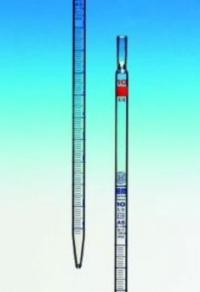Volumetric Pipettes
![]()

Volumetric pipettes, also known as bulb pipettes, are manual liquid handling devices used in many laboratories for the transfer and dispense of a single, specific quantity of liquid to a very high degree of accuracy. They are normally used in conjunction with a suitable pipette filler for user safety, and to minimise potential contamination.
Most volumetric pipettes are made from clear borosilicate glass or soda lime glass for enhanced chemical and heat resistance. Amber glass versions are also available for light-sensitive samples. Disposable plastic volumetric pipettes are also used, although some plastic versions are made of polypropylene and may be autoclavable.
Volumetric pipettes comprise a narrow tip, an elongated stem, and an intermediate bulb or reservoir some way down to increase holding capacity. Most volumetric pipettes are ‘one-mark’ (occasionally two-mark) and are etched or printed on the bulb or stem with the necessary fill level and other information appropriate to the nominal capacity.
Volumetric pipettes are calibrated to deliver (TD) volumes typically ranging from 0.5mL to 100mL or more. They may be designated as Class A, Class AS or Class B depending on their accuracy and tolerance, and many come with certification to accepted manufacturing standards, compliance and conformity, often with individual batch manufacture traceability.
What is a volumetric pipette used for?
Volumetric pipettes have many uses in the laboratory or the wider working environment:
- Creation of serial dilutions and stock solutions
- Titrations and volumetric analysis
- Routine handling of analytical solutions, cell culture media, organic chemicals, solvents and other liquids